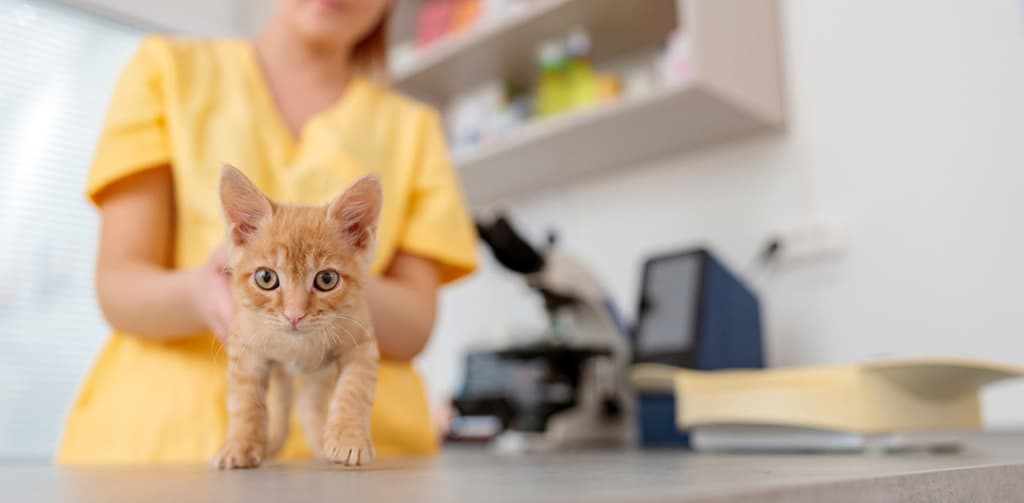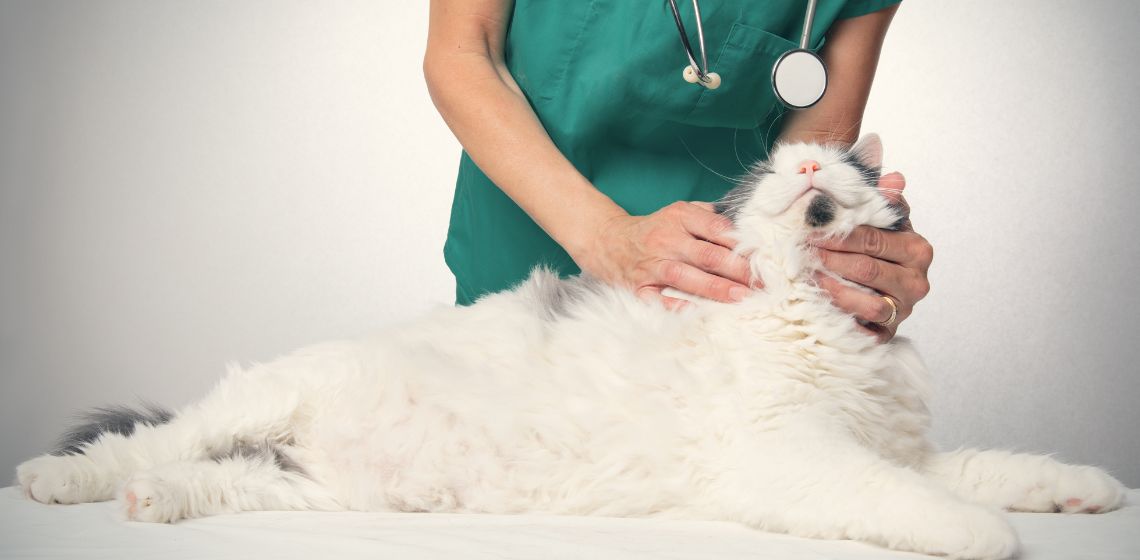Many pet parents are aware that their pets can suffer from worms, but did you know there are different kinds? In this article, we are going to explore the most common types of worms in cats and what you can do if you suspect your pet has an infection.
Severity:
The disease is mild in most cases but may be moderate to severe in cats with very heavy worm burdens.
Table of Contents
Key points
- The most common worms in cats are roundworms, tapeworms, and hookworms
- Worms can be caught by any cat, but are more common in young animals or those with a compromised immune system
- Worms should be treated with veterinarian-recommended anti-parasite products
- Cats should be wormed regularly as part of a preventative treatment plan
Common in
Cats of any age, but especially young animals or those with poor immune systems. Outdoor cats that hunt are also at greater risk.
Symptoms & types
The most common types of parasitic worms found in cats live in their digestive tract. We’ll look at each one in turn.
Roundworm
Roundworms are an extremely common parasite in cats affecting all age groups. They are widespread geographically, with the two most common types being Toxocara cati and Toxascaris leonine. Roundworms can be spread from one cat to another from eggs passed in the feces, or from infected mothers via their milk to the kittens.
Animals with large amounts of roundworm may have a large abdomen or “pot-bellied” appearance. They can also cause lethargy, vomiting, and diarrhea.
Roundworms most commonly infect animals with a lowered immune system such as young cats or those with other conditions such as pregnancy and ill health. Many cats show no symptoms of roundworm infection unless the worms are present in high numbers.
Animals with large amounts of roundworm may have a large abdomen or “pot-bellied” appearance. They can also cause lethargy, vomiting, and diarrhea. In extreme cases a heavy worm burden could lead to an obstruction in the intestines, blocking the passage of food and liquid. This could require emergency surgery to resolve.
It is worth noting that roundworms can be a risk to humans, particularly children. Infectious larvae (an immature stage of the roundworm life cycle) found in fecal material can, on rare occasions, cause health issues in people. This includes stomach pain, vomiting, diarrhea, weight loss, and possible blindness.
Tapeworm
Tapeworms are long, flat, and segmented worms that can vary in length, with Dipylidium caninum and Dipylidium taenia being the species that infect cats. The head has suckers and hooks on it that help the tapeworm anchor to the intestinal wall. This means the worm can stay safely in situ, feeding and growing. As it does so, small segments from the worm become detached and passed out of the cat’s anus. These look like small grains of rice, which might still be moving. These are egg packets, full of many more immature tapeworms!
With tapeworm infections you might notice your cat is excessively itchy around his anus, licking and grooming down there more than usual.
Eggs can be accidentally eaten by cats after contact with infected animals or their feces. Fleas can also carry the larvae of D.caninum, meaning that cats accidentally ingesting a flea while grooming themselves could get a tapeworm. Some species of tapeworm can also migrate into the muscles of an animal, forming cysts. A cat that eats undercooked or raw meat, for example hunting small rodents and birds, could get tapeworm in this way.
With tapeworm infections you might notice your cat is excessively itchy around his anus, licking and grooming down there more than usual. You may see the small tapeworm segments stuck in the fur near your cat’s bottom. Your cat may also have weight loss, despite a good appetite, and show other signs such as poor coat condition.
Hookworms
Ancylostoma ceylanicum, Ancylostoma braziliense, and Ancylostoma tubaeforme are hookworm species that affect cats. The adult worm causes anemia and inflammation in the small intestine, due to the way they suck blood from their host. The bite wounds from this parasite can also seep blood after feeding is finished that is then lost into the digestive tract.
Symptoms of hookworm infection include dark, sticky/tarry feces, diarrhea, or constipation.
Hookworms can be caught by accidental ingestion from a contaminated environment, or through larvae on the ground that penetrate the skin, usually through the paws, between the toes. It can also be spread from mother to kitten via milk.
Symptoms of hookworm infection include dark, sticky/tarry feces (known as melena), diarrhea, or constipation. Cats that are suffering from blood loss may have pale gums, lethargy, and a poor appetite. Some cats may have a cough from larvae migrating to the lungs. Death can occur in some cases, especially in young kittens. Hookworms can potentially infect people too.
Other worms also found in cats
- Whipworms
- Lungworms
- Stomach worms
- Bladder worms
- Liver flukes
- Heartworms
Understanding the diagnostics
A definitive diagnosis of worms is usually made through fecal samples. Samples of your cat’s poo can be processed and looked at under the microscope, where worm eggs might be visible. This will help not only identify if it is worms causing your cat’s problems, but also the type of worm present.
Learning about the causes
As discussed under each individual worm, the parasites can be caught from the environment via contact with infected feces or through other creatures like fleas or wild animals. In the case of roundworms and hookworms, they can even be caught from an infected mother passing them on to her kittens.
Home remedies are not advised for worm prevention or treatment. You should always use a veterinary product and avoid ineffective herbal or “natural” worming products.
Best treatment options
Our veterinarians will be able to advise you on the products that are available for your cat and make recommendations based on their age and size. Worming pastes and liquids are commonly used in very young animals, while adult cats can have worming tablets or spot-on treatments. These drugs contain active ingredients such as fenbendazole and praziquantel.
Repeat dosing may be required to completely treat the infection, especially if there are large numbers of worms. Sometimes you may see dead worms passed in your cat’s feces or vomit, but not always.
Our veterinarians will be able to recommend how often you should administer these products going forward, as they should be given at regular intervals throughout your pet’s life to prevent recurrent infections.
Home remedies & their effectiveness
Home remedies are not advised for worm prevention or treatment. You should always use a veterinary product and avoid ineffective herbal or “natural” worming products.
When to see a vet
You should always see a veterinarian if you have concerns that your cat is unwell, particularly if they have weight loss, changes in appetite, and vomiting or diarrhea.
It’s also worth going to your veterinarian before a problem arises. Our at home vets will happily discuss preventative worm treatments with you. Get off on the right foot by taking your new kitten in for a check over straight away. Remember that cats can be carriers of worms without showing any symptoms at all, so routine anti-parasite treatment is advised, particularly in young animals and those that go outside and hunt.
FAQ
De-worming products are advised to treat worms in cats, ideally ones recommended by your veterinary professional.
These vary depending on the type of worm but can include weight loss despite a keen appetite, poor coat condition, a pot-bellied appearance, and tummy upsets. Sometimes lethargy and anemia can occur too.
Adult tapeworms are long and flat, like a piece of ribbon or tape. As the worm matures segments called proglottids detach and pass out through the cat’s anus and into their feces. These small segments are the size of a grain of rice, but an adult tapeworm inside your pet can be 4-28 inches in length!

Rebecca is a companion animal vet who has always had a passion for writing and client communication. Since her graduation from the Royal Veterinary college in 2009, she has gained a wealth of experience in first opinion small animal practice, in both clinical and managerial roles. She currently works in the South West and deals with a variety of routine and emergency appointments, but particularly enjoys medicine cases. Outside of work and writing, she enjoys spending time with her family, including her bouncy flat-coated retriever George!










